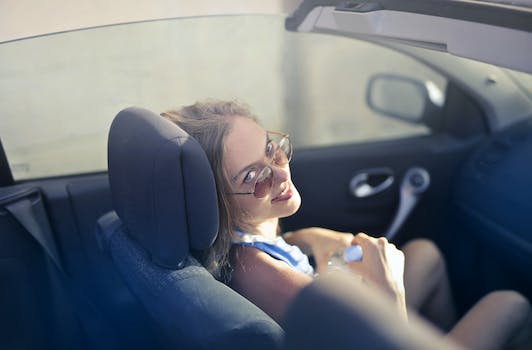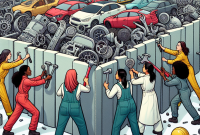
The History of Convertible Cars: Open-Air Freedom
-
Table of Contents
- Introduction
- The Evolution of Convertible Cars: From Early Horse-Drawn Carriages to Modern Automobiles
- The Rise of the Convertible: How the Open-Air Design Became a Popular Choice
- The History of Convertible Car Safety: How Manufacturers Have Improved Safety Features Over Time
- The Iconic Convertible Cars of the 1950s and 1960s: A Look at the Most Popular Models
- The Future of Convertible Cars: What Innovations Are on the Horizon?
- Q&A
- Conclusion
Through the Ages
“Experience the Thrill of the Open Road: The Evolution of Convertible Cars Through Time!”
Introduction
The convertible car has been around for over a century, and it has been a symbol of freedom and adventure ever since. Convertible cars have been a part of automotive history since the early 1900s, and they have been a popular choice for drivers who want to enjoy the open air while driving. Convertibles have come a long way since their early days, and they are now available in a variety of styles and sizes. From classic roadsters to modern luxury convertibles, there is a convertible car for everyone. This article will explore the history of convertible cars and how they have evolved over the years.
The Evolution of Convertible Cars: From Early Horse-Drawn Carriages to Modern Automobiles
The history of convertible cars is a fascinating one, tracing its roots back to the early days of horse-drawn carriages. While the modern convertible car is a far cry from its predecessors, the evolution of the vehicle has been an interesting one.
In the early days of the automobile, horse-drawn carriages were the primary mode of transportation. These carriages were often open-air, allowing passengers to enjoy the fresh air and scenery as they traveled. As the automobile began to gain popularity, the open-air carriage was adapted to become the first convertible car.
The first convertible cars were produced in the early 1900s. These cars featured a removable roof, allowing passengers to enjoy the open air while driving. The first convertibles were often made of wood and canvas, and were not particularly reliable. However, they were popular among those who wanted to experience the thrill of driving with the wind in their hair.
As technology advanced, so did the design of the convertible car. By the 1930s, convertibles were made of metal and featured more reliable engines. The cars were also equipped with roll-up windows, allowing passengers to enjoy the open air without the wind and dust.
The 1950s saw the introduction of the hardtop convertible. This type of convertible featured a removable hardtop, allowing passengers to enjoy the open air without having to remove the entire roof. This type of convertible was popular among those who wanted the convenience of a hardtop car with the open-air experience of a convertible.
Today, convertible cars are more reliable and feature more advanced technology than ever before. Modern convertibles are equipped with air conditioning, power windows, and other features that make them comfortable and enjoyable to drive.
The evolution of the convertible car has been an interesting one, from its early days as a horse-drawn carriage to its modern incarnation as a reliable and comfortable automobile. Whether you’re looking for a classic convertible or a modern one, there’s sure to be a car that fits your needs.
The Rise of the Convertible: How the Open-Air Design Became a Popular Choice
The convertible has been a popular choice for drivers since the early 1900s, and its open-air design has been a major factor in its success. From the earliest days of the automobile, drivers have been drawn to the idea of being able to enjoy the open road with the wind in their hair. Today, convertibles are more popular than ever, and they offer a unique driving experience that can’t be found in other types of vehicles.
The first convertibles were introduced in the early 1900s, and they quickly became a hit with drivers. The open-air design allowed drivers to enjoy the sights and sounds of the road without having to be enclosed in a metal box. This was a major selling point for drivers, and it helped to make the convertible a popular choice.
The popularity of the convertible continued to grow throughout the 20th century, and manufacturers began to offer more and more models. By the 1950s, convertibles had become a staple of the automotive industry, and they were available in a variety of styles and sizes. This allowed drivers to find the perfect convertible for their needs, and it helped to make the open-air design even more popular.
Today, convertibles are more popular than ever, and they offer a unique driving experience that can’t be found in other types of vehicles. From classic models to modern designs, there is a convertible for every driver. Whether you’re looking for a classic car to take on a weekend cruise or a modern convertible to take on a cross-country road trip, there is a convertible that will fit your needs.
The open-air design of the convertible has been a major factor in its success, and it continues to be a popular choice for drivers today. With its unique driving experience and classic style, the convertible is sure to remain a popular choice for years to come.
The History of Convertible Car Safety: How Manufacturers Have Improved Safety Features Over Time

The convertible car has been a popular choice for drivers since the early 1900s. While the open-air design of these vehicles has always been a major draw, safety has been a concern for many drivers. Over the years, car manufacturers have worked hard to improve the safety features of convertibles, making them a safer option for drivers.
In the early days of convertible cars, safety features were minimal. The most common safety feature was a roll bar, which was designed to protect the driver and passengers in the event of a rollover. However, these roll bars were often made of metal and could be dangerous in the event of a crash.
In the 1950s, car manufacturers began to focus more on safety features. Seatbelts were added to convertibles, as well as reinforced frames and stronger windshields. These features helped to reduce the risk of injury in the event of a crash.
In the 1970s, airbags were added to convertibles. This was a major step forward in terms of safety, as airbags can help to reduce the risk of serious injury in the event of a crash.
In the 1990s, car manufacturers began to focus on improving the structural integrity of convertibles. Reinforced frames and stronger windshields were added to help reduce the risk of injury in the event of a crash.
Today, car manufacturers are continuing to focus on safety features for convertibles. Many models now come with advanced safety features such as blind spot monitoring, lane departure warning systems, and adaptive cruise control. These features help to reduce the risk of injury in the event of a crash.
Over the years, car manufacturers have worked hard to improve the safety features of convertibles. From roll bars to airbags to advanced safety features, these vehicles have become much safer over time. As a result, convertibles are now a much safer option for drivers.
The Iconic Convertible Cars of the 1950s and 1960s: A Look at the Most Popular Models
The 1950s and 1960s were a golden age for the automobile industry, with many iconic models being released during this time. Convertible cars were particularly popular during this era, with many of them becoming timeless classics. In this article, we’ll take a look at some of the most popular convertible cars of the 1950s and 1960s.
The Chevrolet Corvette is one of the most iconic cars of the era. It was first released in 1953 and quickly became a symbol of American muscle. The Corvette was the first mass-produced sports car in the United States and featured a powerful V8 engine. It was also the first car to feature a fiberglass body, which made it lighter and more aerodynamic.
The Ford Thunderbird was another popular convertible of the era. It was released in 1955 and was designed to compete with the Corvette. The Thunderbird featured a powerful V8 engine and a luxurious interior. It was also the first car to feature a retractable hardtop, which made it a popular choice for those who wanted the convenience of a convertible without sacrificing style.
The Volkswagen Beetle was another iconic car of the era. It was first released in 1938 and quickly became a symbol of the counterculture movement. The Beetle was known for its unique design and its air-cooled engine. It was also one of the most affordable cars of the era, making it a popular choice for those on a budget.
The Austin-Healey 3000 was another popular convertible of the era. It was released in 1959 and was designed to compete with the Corvette and the Thunderbird. The 3000 featured a powerful inline-six engine and a luxurious interior. It was also one of the first cars to feature a roll bar, which made it safer in the event of a rollover.
The Jaguar E-Type was another iconic convertible of the era. It was released in 1961 and quickly became a symbol of luxury and performance. The E-Type featured a powerful inline-six engine and a sleek design. It was also one of the first cars to feature a monocoque chassis, which made it lighter and more aerodynamic.
These are just a few of the iconic convertible cars of the 1950s and 1960s. Each of these cars has become a timeless classic and is still popular today. Whether you’re looking for a classic car to restore or just want to experience the nostalgia of the era, these cars are sure to please.
The Future of Convertible Cars: What Innovations Are on the Horizon?
The convertible car has been a popular choice for drivers for decades, offering a unique combination of style, performance, and convenience. As technology continues to evolve, so too does the convertible car, with new innovations and features being developed to make the driving experience even more enjoyable. Here, we take a look at some of the exciting innovations that are on the horizon for convertible cars.
One of the most exciting developments in the world of convertible cars is the introduction of electric powertrains. Electric convertibles offer a number of advantages over their gasoline-powered counterparts, including improved fuel efficiency, lower emissions, and quieter operation. Electric convertibles are also becoming increasingly affordable, making them a viable option for many drivers.
Another innovation that is being explored is the use of advanced materials in the construction of convertible cars. Lightweight materials such as carbon fiber and aluminum are being used to reduce the overall weight of the vehicle, resulting in improved performance and fuel efficiency. Additionally, these materials are also more resistant to corrosion and wear, making them a great choice for long-term use.
Safety is also a major focus for convertible car manufacturers, with a number of new features being developed to keep drivers and passengers safe. Automated emergency braking systems, lane-keeping assistance, and blind-spot monitoring are just some of the features that are being developed to help keep drivers safe on the road.
Finally, the use of advanced infotainment systems is becoming increasingly popular in convertible cars. These systems allow drivers to access a range of features, such as navigation, music streaming, and hands-free calling, all from the comfort of their vehicle.
These are just some of the exciting innovations that are on the horizon for convertible cars. As technology continues to evolve, so too will the features and capabilities of these vehicles, making them an even more attractive option for drivers.
Q&A
1. What is the earliest known convertible car?
The earliest known convertible car is the 1898 Spyker 60HP, which was designed by Dutch brothers Jacobus and Hendrik-Jan Spijker.
2. What is the most popular convertible car?
The most popular convertible car is the Ford Mustang, which has been in production since 1964.
3. What are the benefits of owning a convertible car?
The benefits of owning a convertible car include increased visibility, improved fuel economy, and the ability to enjoy the open air.
4. What are the drawbacks of owning a convertible car?
The drawbacks of owning a convertible car include increased noise levels, decreased security, and decreased storage space.
5. What safety features are available on modern convertible cars?
Modern convertible cars are equipped with a variety of safety features, including rollover protection systems, reinforced A-pillars, and airbags.
Conclusion
The history of convertible cars is a long and varied one, with many different models and styles of cars being produced over the years. From the earliest days of the automobile, when open-air cars were the only option, to the modern day, when convertibles are a popular choice for those looking for a fun and stylish ride, the convertible car has been a part of automotive history for over a century. Whether you’re looking for a classic car to restore or a modern car to enjoy, a convertible car is sure to provide you with the open-air freedom and style that you desire.






